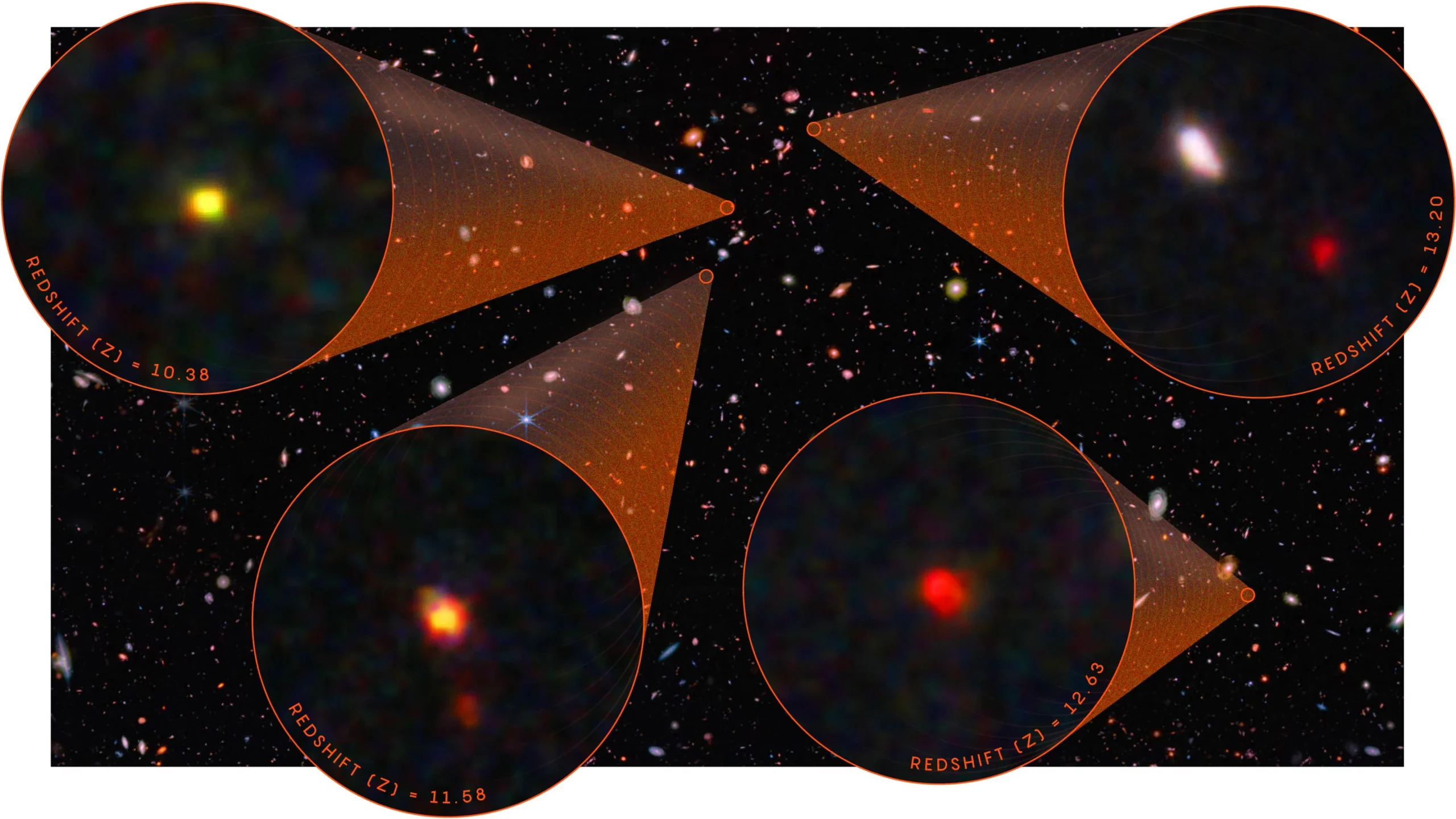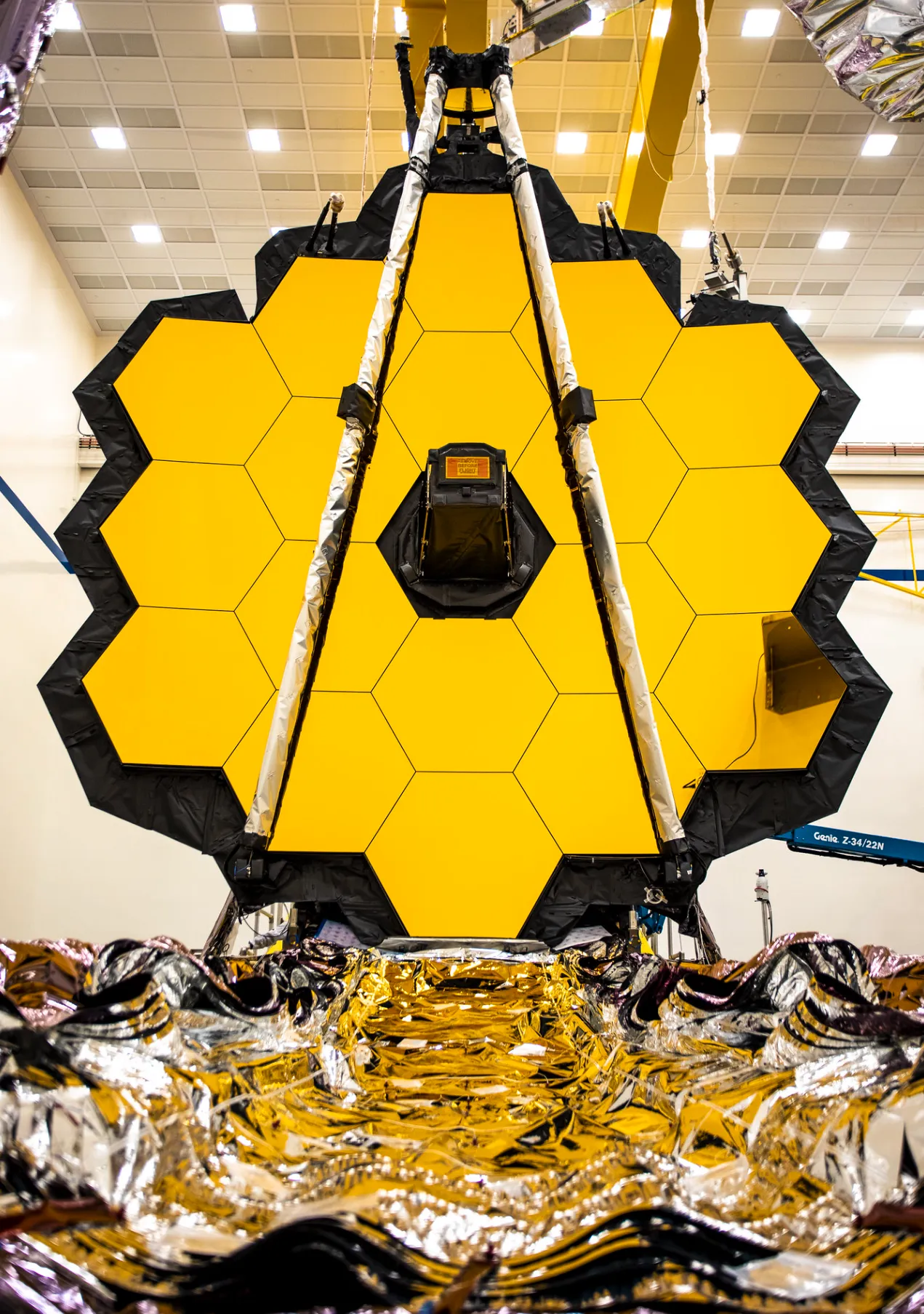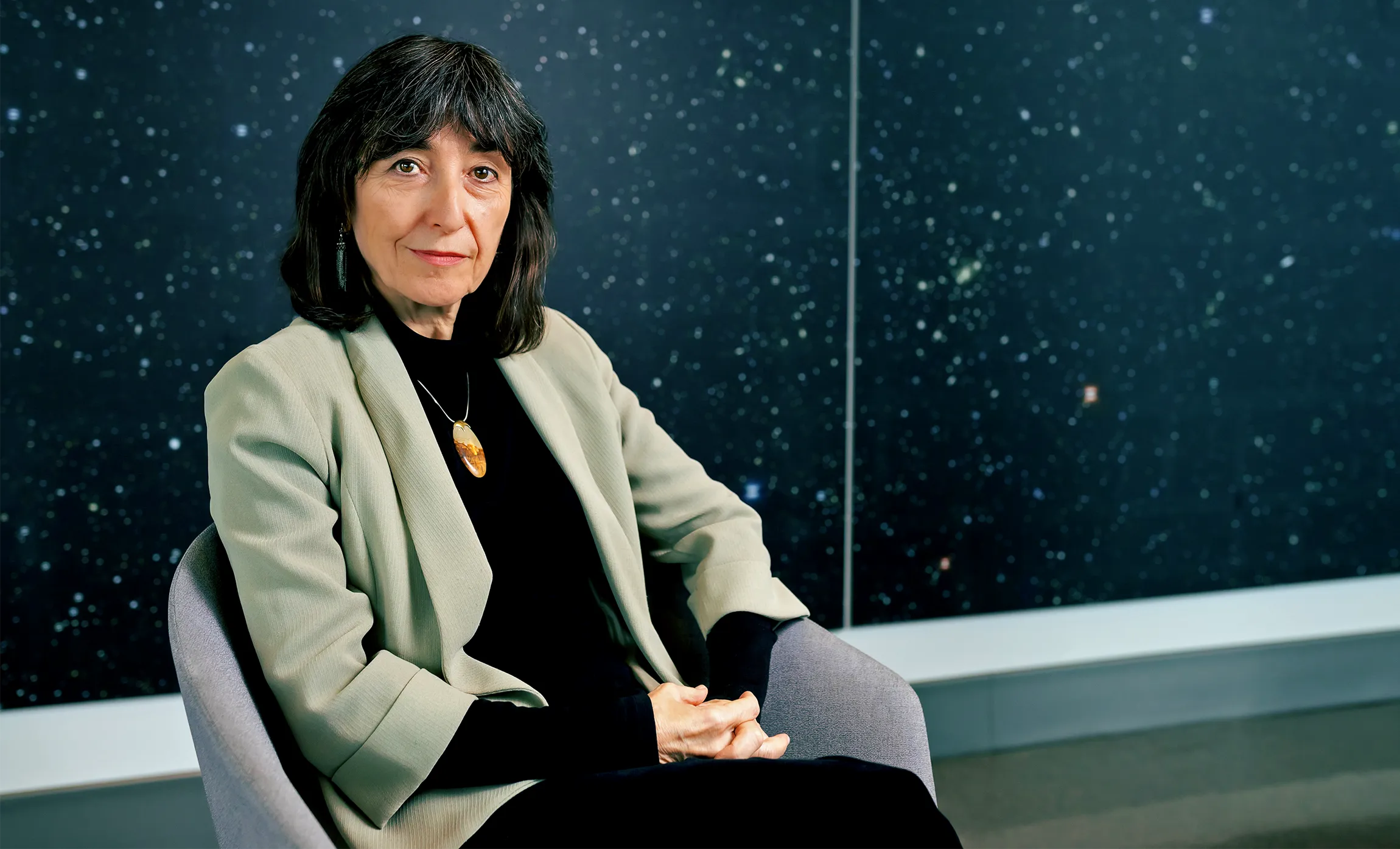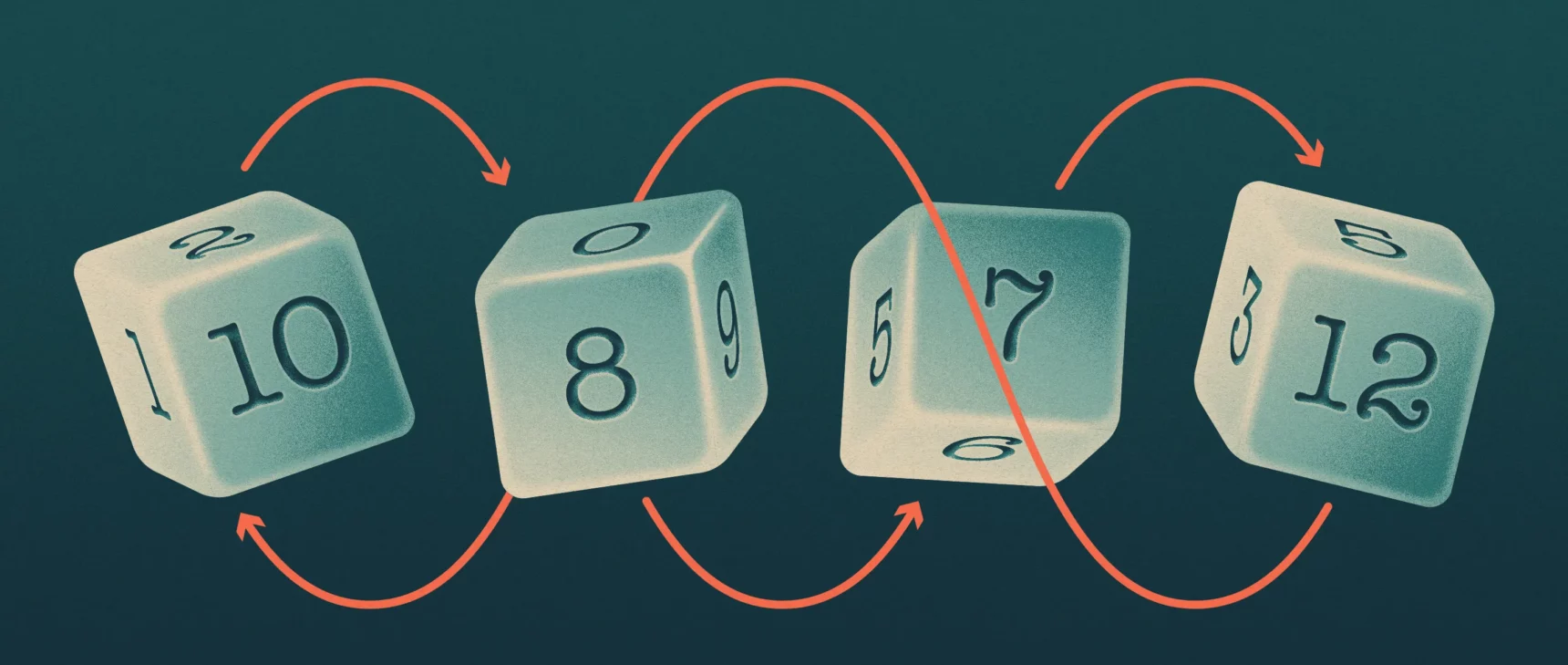Standard Model of Cosmology Survives a Telescope’s Surprising Finds

The Webb telescope has spotted galaxies surprisingly far away in space and deep in the past. These four, studied by a team called JADES, are all seen as they appeared less than 500 million years after the Big Bang.
Samuel Velasco/Quanta Magazine; source: NASA
Introduction
The cracks in cosmology were supposed to take a while to appear. But when the James Webb Space Telescope (JWST) opened its lens last spring, extremely distant yet very bright galaxies immediately shone into the telescope’s field of view. “They were just so stupidly bright, and they just stood out,” said Rohan Naidu, an astronomer at the Massachusetts Institute of Technology.
The galaxies’ apparent distances from Earth suggested that they formed much earlier in the history of the universe than anyone anticipated. (The farther away something is, the longer ago its light flared forth.) Doubts swirled, but in December, astronomers confirmed that some of the galaxies are indeed as distant, and therefore as primordial, as they seem. The earliest of those confirmed galaxies shed its light 330 million years after the Big Bang, making it the new record-holder for the earliest known structure in the universe. That galaxy was rather dim, but other candidates loosely pegged to the same time period were already shining bright, meaning they were potentially humongous.
How could stars ignite inside superheated clouds of gas so soon after the Big Bang? How could they hastily weave themselves into such huge gravitationally bound structures? Finding such big, bright, early galaxies seems akin to finding a fossilized rabbit in Precambrian strata. “There are no big things at early times. It takes a while to get to big things,” said Mike Boylan-Kolchin, a theoretical physicist at the University of Texas, Austin.
Astronomers began asking whether the profusion of early big things defies the current understanding of the cosmos. Some researchers and media outlets claimed that the telescope’s observations were breaking the standard model of cosmology — a well-tested set of equations called the lambda cold dark matter, or ΛCDM, model — thrillingly pointing to new cosmic ingredients or governing laws. It has since become clear, however, that the ΛCDM model is resilient. Instead of forcing researchers to rewrite the rules of cosmology, the JWST findings have astronomers rethinking how galaxies are made, especially in the cosmic beginning. The telescope has not yet broken cosmology, but that doesn’t mean the case of the too-early galaxies will turn out to be anything but epochal.
Simpler Times
To see why the detection of very early, bright galaxies is surprising, it helps to understand what cosmologists know — or think they know — about the universe.
After the Big Bang, the infant universe began cooling off. Within a few million years, the roiling plasma that filled space settled down, and electrons, protons and neutrons combined into atoms, mostly neutral hydrogen. Things were quiet and dark for a period of uncertain duration known as the cosmic dark ages. Then something happened.
Most of the material that flew apart after the Big Bang is made of something we can’t see, called dark matter. It has exerted a powerful influence over the cosmos, especially at first. In the standard picture, cold dark matter (a term that means invisible, slow-moving particles) was flung about the cosmos indiscriminately. In some areas its distribution was denser, and in these regions it began collapsing into clumps. Visible matter, meaning atoms, clustered around the clumps of dark matter. As the atoms cooled off as well, they eventually condensed, and the first stars were born. These new sources of radiation recharged the neutral hydrogen that filled the universe during the so-called epoch of reionization. Through gravity, larger and more complex structures grew, building a vast cosmic web of galaxies.
![Shadows of scientists are seen in front of a panel of screens displaying images of the universe.]](https://www.quantamagazine.org/wp-content/uploads/2023/01/mosaic3.webp)
Astronomers with the CEERS survey, who are using the James Webb Space Telescope to study the early universe, look at a mosaic of images from the telescope in a visualization lab at the University of Texas, Austin.
Nolan Zunk/University of Texas at Austin
Meanwhile, everything kept flying apart. The astronomer Edwin Hubble figured out in the 1920s that the universe is expanding, and in the late 1990s, his namesake, the Hubble Space Telescope, found evidence that the expansion is accelerating. Think of the universe as a loaf of raisin bread. It starts as a mixture of flour, water, yeast and raisins. When you combine these ingredients, the yeast begins respiring and the loaf begins to rise. The raisins within it — stand-ins for galaxies — stretch further apart from one another as the loaf expands.
The Hubble telescope saw that the loaf is rising ever faster. The raisins are flying apart at a rate that defies their gravitational attraction. This acceleration appears to be driven by the repulsive energy of space itself — so-called dark energy, which is represented by the Greek letter Λ (pronounced “lambda”). Plug values for Λ, cold dark matter, and regular matter and radiation into the equations of Albert Einstein’s general theory of relativity, and you get a model of how the universe evolves. This “lambda cold dark matter” (ΛCDM) model matches almost all observations of the cosmos.
One way to test this picture is by looking at very distant galaxies — equivalent to looking back in time to the first few hundred million years after the tremendous clap that started it all. The cosmos was simpler then, its evolution easier to compare against predictions.
Astronomers first tried to see the earliest structures of the universe using the Hubble telescope in 1995. Over 10 days, Hubble captured 342 exposures of an empty-looking patch of space in the Big Dipper. Astronomers were astonished by the abundance hiding in the inky dark: Hubble could see thousands of galaxies at different distances and stages of development, stretching back to much earlier times than anyone expected. Hubble would go on to find some exceedingly distant galaxies — in 2016, astronomers found its most distant one, called GN-z11, a faint smudge that they dated to 400 million years after the Big Bang.
That was surprisingly early for a galaxy, but it did not cast doubt on the ΛCDM model in part because the galaxy is tiny, with just 1% of the Milky Way’s mass, and in part because it stood alone. Astronomers needed a more powerful telescope to see whether GN-z11 was an oddball or part of a larger population of puzzlingly early galaxies, which could help determine whether we are missing a crucial piece of the ΛCDM recipe.
Unaccountably Distant
That next-generation space telescope, named for former NASA leader James Webb, launched on Christmas Day 2021. As soon as JWST was calibrated, light from early galaxies dripped into its sensitive electronics. Astronomers published a flood of papers describing what they saw.

The James Webb Space Telescope, a joint venture of space agencies in the United States, Europe and Canada that took decades to design, build and test, was launched into space on December 25, 2021.
Northrop Grumman
Researchers use a version of the Doppler effect to gauge the distances of objects. This is similar to figuring out the location of an ambulance based on its siren: The siren sounds higher in pitch as it approaches and then lower as it recedes. The farther away a galaxy is, the faster it moves away from us, and so its light stretches to longer wavelengths and appears redder. The magnitude of this “redshift” is expressed as z, where a given value for z tells you how long an object’s light must have traveled to reach us.
One of the first papers on JWST data came from Naidu, the MIT astronomer, and his colleagues, whose search algorithm flagged a galaxy that seemed inexplicably bright and unaccountably distant. Naidu dubbed it GLASS-z13, indicating its apparent distance at a redshift of 13 — further away than anything seen before. (The galaxy’s redshift was later revised down to 12.4, and it was renamed GLASS-z12.) Other astronomers working on the various sets of JWST observations were reporting redshift values from 11 to 20, including one galaxy called CEERS-1749 or CR2-z17-1, whose light appears to have left it 13.7 billion years ago, just 220 million years after the Big Bang — barely an eyeblink after the beginning of cosmic time.
These putative detections suggested that the neat story known as ΛCDM might be incomplete. Somehow, galaxies grew huge right away. “In the early universe, you don’t expect to see massive galaxies. They haven’t had time to form that many stars, and they haven’t merged together,” said Chris Lovell, an astrophysicist at the University of Portsmouth in England. Indeed, in a study published in November, researchers analyzed computer simulations of universes governed by the ΛCDM model and found that JWST’s early, bright galaxies were an order of magnitude heavier than the ones that formed concurrently in the simulations.
Some astronomers and media outlets claimed that JWST was breaking cosmology, but not everyone was convinced. One problem is that ΛCDM’s predictions aren’t always clear-cut. While dark matter and dark energy are simple, visible matter has complex interactions and behaviors, and nobody knows exactly what went down in the first years after the Big Bang; those frenetic early times must be approximated in computer simulations. The other problem is that it’s hard to tell exactly how far away galaxies are.
In the months since the first papers, the ages of some of the alleged high-redshift galaxies have been reconsidered. Some were demoted to later stages of cosmic evolution because of updated telescope calibrations. CEERS-1749 is found in a region of the sky containing a cluster of galaxies whose light was emitted 12.4 billion years ago, and Naidu says it’s possible the galaxy is actually part of this cluster — a nearer interloper that might be filled with dust that makes it appear more redshifted than it is. According to Naidu, CEERS-1749 is weird no matter how far away it is. “It would be a new type of galaxy that we did not know of: a very low-mass, tiny galaxy that has somehow built up a lot of dust in it, which is something we traditionally do not expect,” he said. “There might just be these new types of objects that are confounding our searches for the very distant galaxies.”
The Lyman Break
Everyone knew that the most definitive distance estimates would require JWST’s most powerful capability.
JWST not only observes starlight through photometry, or measuring brightness, but also through spectroscopy, or measuring the light’s wavelengths. If a photometric observation is like a picture of a face in a crowd, then a spectroscopic observation is like a DNA test that can tell an individual’s family history. Naidu and others who found large early galaxies measured redshift using brightness-derived measurements — essentially looking at faces in the crowd using a really good camera. That method is far from airtight. (At a January meeting of the American Astronomical Society, astronomers quipped that maybe half of the early galaxies observed with photometry alone will turn out to be accurately measured.)
But in early December, cosmologists announced that they had combined both methods for four galaxies. The JWST Advanced Deep Extragalactic Survey (JADES) team searched for galaxies whose infrared light spectrum abruptly cuts off at a critical wavelength known as the Lyman break. This break occurs because hydrogen floating in the space between galaxies absorbs light. Because of the continuing expansion of the universe — the ever-rising raisin loaf — the light of distant galaxies is shifted, so the wavelength of that abrupt break shifts too. When a galaxy’s light appears to drop off at longer wavelengths, it is more distant. JADES identified spectra with redshifts up to 13.2, meaning the galaxy’s light was emitted 13.4 billion years ago.
Merrill Sherman/Quanta Magazine
As soon as the data was downlinked, JADES researchers began “freaking out” in a shared Slack group, according to Kevin Hainline, an astronomer at the University of Arizona. “It was like, ‘Oh my God, oh my God, we did it we did it we did it!’” he said. “These spectra are just the beginning of what I think is going to be astronomy-changing science.”
Brant Robertson, a JADES astronomer at the University of California, Santa Cruz, says the findings show that the early universe changed rapidly in its first billion years, with galaxies evolving 10 times quicker than they do today. It’s similar to how “a hummingbird is a small creature,” he said, “but its heart beats so quickly that it is living kind of a different life than other creatures. The heartbeat of these galaxies is happening on a much more rapid timescale than something the size of the Milky Way.”
But were their hearts beating too fast for ΛCDM to explain?
Theoretical Possibilities
As astronomers and the public gaped at JWST images, researchers started working behind the scenes to determine whether the galaxies blinking into our view really upend ΛCDM or just help nail down the numbers we should plug into its equations.
One important yet poorly understood number concerns the masses of the earliest galaxies. Cosmologists try to determine their masses in order to tell whether they match ΛCDM’s predicted timeline of galaxy growth.
A galaxy’s mass is derived from its brightness. But Megan Donahue, an astrophysicist at Michigan State University, says that at best, the relationship between mass and brightness is an educated guess, based on assumptions gleaned from known stars and well-studied galaxies.
One key assumption is that stars always form within a certain statistical range of masses, called the initial mass function (IMF). This IMF parameter is crucial for gleaning a galaxy’s mass from measurements of its brightness, because hot, blue, heavy stars produce more light, while the majority of a galaxy’s mass is typically locked up in cool, red, small stars.
But it’s possible that the IMF was different in the early universe. If so, JWST’s early galaxies might not be as heavy as their brightness suggests; they might be bright but light. This possibility causes headaches, because changing this basic input to the ΛCDM model could give you almost any answer you want. Lovell says some astronomers consider fiddling with the IMF “the domain of the wicked.”

Wendy Freedman at the University of Chicago is exploring how JWST observations can be squared with the standard cosmological model.
Nancy Wong
“If we don’t understand the initial mass function, then understanding galaxies at high redshift is really a challenge,” said Wendy Freedman, an astrophysicist at the University of Chicago. Her team is working on observations and computer simulations that will help pin down the IMF in different environments.
Over the course of the fall, many experts came to suspect that tweaks to the IMF and other factors could be enough to square the very ancient galaxies lighting upon JWST’s instruments with ΛCDM. “I think it’s actually more likely that we can accommodate these observations within the standard paradigm,” said Rachel Somerville, an astrophysicist at the Flatiron Institute (which, like Quanta Magazine, is funded by the Simons Foundation). In that case, she said, “what we learn is: How fast can [dark matter] halos collect the gas? How fast can we make the gas cool off and get dense, and make stars? Maybe that happens faster in the early universe; maybe the gas is denser; maybe somehow it is flowing in faster. I think we’re still learning about those processes.”
Somerville also studies the possibility that black holes interfered with the baby cosmos. Astronomers have noticed a few glowing supermassive black holes at a redshift of 6 or 7, about a billion years after the Big Bang. It is hard to conceive of how, by that time, stars could have formed, died and then collapsed into black holes that ate everything surrounding them and began spewing radiation.
But if there are black holes inside the putative early galaxies, that could explain why the galaxies seem so bright, even if they’re not actually very massive, Somerville said.
Confirmation that ΛCDM can accommodate at least some of JWST’s early galaxies arrived the day before Christmas. Astronomers led by Benjamin Keller at the University of Memphis checked a handful of major supercomputer simulations of ΛCDM universes and found that the simulations could produce galaxies as heavy as the four that were spectroscopically studied by the JADES team. (These four are, notably, smaller and dimmer than other purported early galaxies such as GLASS-z12.) In the team’s analysis, all the simulations yielded galaxies the size of the JADES findings at a redshift of 10. One simulation could create such galaxies at a redshift of 13, the same as what JADES saw, and two others could build the galaxies at an even higher redshift. None of the JADES galaxies was in tension with the current ΛCDM paradigm, Keller and colleagues reported on the preprint server arxiv.org on December 24.
Though they lack the heft to break the prevailing cosmological model, the JADES galaxies have other special characteristics. Hainline said their stars seem unpolluted by metals from previously exploded stars. This could mean they are Population III stars — the avidly sought first generation of stars to ever ignite — and that they may be contributing to the reionization of the universe. If this is true, then JWST has already peered back to the mysterious period when the universe was set on its present course.
Extraordinary Evidence
Spectroscopic confirmation of additional early galaxies could come this spring, depending on how JWST’s time allocation committee divvies things up. An observing campaign called WDEEP will specifically search for galaxies from less than 300 million years after the Big Bang. As researchers confirm more galaxies’ distances and get better at estimating their masses, they’ll help settle ΛCDM’s fate.
Many other observations are already underway that could change the picture for ΛCDM. Freedman, who is studying the initial mass function, was up at 1 a.m. one night downloading JWST data on variable stars that she uses as “standard candles” for measuring distances and ages. Those measurements could help shake out another potential problem with ΛCDM, known as the Hubble tension. The problem is that the universe currently seems to be expanding faster than ΛCDM predicts for a 13.8-billion-year-old universe. Cosmologists have plenty of possible explanations. Perhaps, some cosmologists speculate, the density of the dark energy that’s accelerating the expansion of the universe is not constant, as in ΛCDM, but changes over time. Changing the expansion history of the universe might not only resolve the Hubble tension but also revise calculations of the age of the universe at a given redshift. JWST might be seeing an early galaxy as it appeared, say, 500 million years after the Big Bang rather than 300 million. Then even the heaviest putative early galaxies in JWST’s mirrors would have had plenty of time to coalesce, says Somerville.
Astronomers run out of superlatives when they talk about JWST’s early galaxy results. They pepper their conversations with laughter, expletives and exclamations, even as they remind themselves of Carl Sagan’s adage, however overused, that extraordinary claims require extraordinary evidence. They can’t wait to get their hands on more images and spectra, which will help them hone or tweak their models. “Those are the best problems,” said Boylan-Kolchin, “because no matter what you get, the answer is interesting.”



